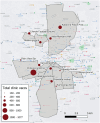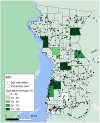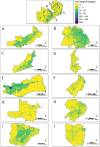Rabies vaccinations at the rural-urban divide: successes and barriers to dog rabies vaccination programs from a rural and urban campaign in Zambia
- PMID: 39902336
- PMCID: PMC11789232
- DOI: 10.3389/fvets.2024.1492418
Rabies vaccinations at the rural-urban divide: successes and barriers to dog rabies vaccination programs from a rural and urban campaign in Zambia
Abstract
Introduction: Dog vaccination against rabies is considered one of the most effective strategies at preventing human deaths from rabies and is a key strategy for eliminating dog-mediated human rabies deaths. Traditional vaccination approaches in Zambia rarely collect operational data to assess coverage and inform subsequent campaigns.
Methods: Following mass vaccination campaigns in rural (Itezhi tezhi) and urban (Lusaka) communities, we evaluated vaccination coverage achieved during the campaigns and characterized and estimated the dog population in these communities.
Results: Herd immunity (i.e., 70% vaccination coverage) was not achieved in the Lusaka campaign, likely due to challenges in pre-campaign community sensitization and distance to vaccination sites in the central point campaign approach. Dog population density showed a strong exponential association with human density (R2 = 0.89). Extrapolating this relationship nationally, there are an estimated 3.2 million dogs in Zambia (human-to-dog ratio 5.8:1) with 86% residing in rural communities at a very low density of less than 6 dogs per square kilometer.
Discussion: As most dogs were found to reside at very low densities, unique challenges to large-scale dog vaccination approaches may impact Zambia, due to high logistical costs associated with these settings. Prioritizing vaccinations in higher-density free-roaming dog populations could maximize effectiveness in resource-limited settings. Private veterinary services were commonly utilized among surveyed dog owners in urbanized communities in Lusaka, suggesting that they are an important collaborator for achieving rabies herd immunity. With improved knowledge of dog population and ownership characteristics, Zambia is well-prepared to design more effective vaccination campaigns as the rabies elimination program expands.
Keywords: dog vaccination programs; dog-mediated human rabies elimination; dog-mediated rabies; rabies; rabies vaccination.
Copyright © 2025 Chazya, Mulenga, Gibson, Lohr, Boutelle, Bonaparte, Sinywibulula, Thomas, Bwalya, Dautu, Munsimbwe, Muuka, Gamble, Wallace and Waltenburg.
Conflict of interest statement
The authors declare that the research was conducted in the absence of any commercial or financial relationships that could be construed as a potential conflict of interest. The reviewer SS declared a shared affiliation with the authors CB, SB, RMW, MAW to the handling editor at the time of review.
Figures









References
-
- Nakazwe C, Gianetti B, Chazya R, Ngomah A. (2019). Zero human rabies deaths: a one health approach to rabies elimination in Zambia. Perspectives/the health press. Zambia National Public Health Institute. Available at: webworxzambia.com/znphi/2019/12/02/zero-human-rabies-deaths-a-one-health.../
-
- Babaniyi O, Songolo P, Matapo B, Masaninga F, Mulenga F, Michelo C, et al. . Epidemiological characteristics of rabies in Zambia: a retrospective study (2004–2013). Clin Epidemiol Glob Health. (2016) 4:83–8. doi: 10.1016/j.cegh.2016.01.003 - DOI
LinkOut - more resources
Full Text Sources
Research Materials

